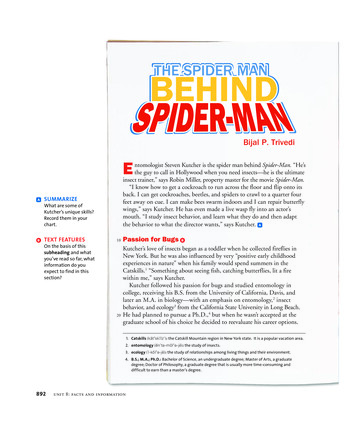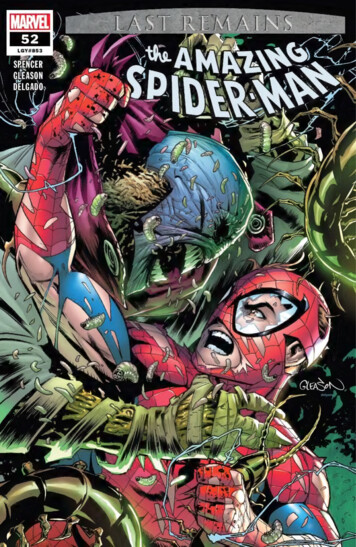
Transcription
Bijal P. Trivedintomologist Steven Kutcher is the spider man behind Spider-Man. “He’sthe guy to call in Hollywood when you need insects—he is the ultimateinsect trainer,” says Robin Miller, property master for the movie Spider-Man.“I know how to get a cockroach to run across the floor and flip onto itsback. I can get cockroaches, beetles, and spiders to crawl to a quarter fourfeet away on cue. I can make bees swarm indoors and I can repair butterflywings,” says Kutcher. He has even made a live wasp fly into an actor’smouth. “I study insect behavior, and learn what they do and then adaptthe behavior to what the director wants,” says Kutcher. aEaSUMMARIZEWhat are some ofKutcher’s unique skills?Record them in yourchart.bTEXT FEATURES10On the basis of thissubheading and whatyou’ve read so far, whatinformation do youexpect to find in thissection?20Passion for BugsbKutcher’s love of insects began as a toddler when he collected fireflies inNew York. But he was also influenced by very “positive early childhoodexperiences in nature” when his family would spend summers in theCatskills.1 “Something about seeing fish, catching butterflies, lit a firewithin me,” says Kutcher.Kutcher followed his passion for bugs and studied entomology incollege, receiving his B.S. from the University of California, Davis, andlater an M.A. in biology—with an emphasis on entomology,2 insectbehavior, and ecology3 from the California State University in Long Beach.He had planned to pursue a Ph.D.,4 but when he wasn’t accepted at thegraduate school of his choice he decided to reevaluate his career options.1. Catskills (kBtPskGlzQ): the Catskill Mountain region in New York state. It is a popular vacation area.2. entomology (DnQtE-mJlPE-jC): the study of insects.3. ecology (G-kJlPE-jC): the study of relationships among living things and their environment.4. B.S.; M.A.; Ph.D.: Bachelor of Science, an undergraduate degree; Master of Arts, a graduatedegree; Doctor of Philosophy, a graduate degree that is usually more time-consuming anddifficult to earn than a master’s degree.892unit 8: facts and information892-896 NA L08PE-u08s01-Spider.indd 8921/18/11 12:52:17 PM
Based on this photoof Steven Kutcher,what can you inferabout his interests andpersonality?the spider man behind892-896 NA L08PE-u08s01-Spider.indd 893SPIDER - MAN8931/18/11 12:52:26 PM
potential (pE-tDnPshEl)n. the ability to grow ordevelopengaging (Dn-gAjPGng)adj. charming; likeable30One day he received a call from his former academic advisor asking himto baby-sit 3,000 locusts that were to be used for the movie Exorcist 2.Kutcher had to place the locusts wherever they were needed, including onthe stars Richard Burton and Linda Blair. That was his first job, and it hasbeen Hollywood creepy crawlies ever since.After doing a long survey of movies Kutcher found that about one third ofall movies had an insect in it. “I saw immediate job potential,” Kutcher says.Almost 25 years after his first job Kutcher now holds an impressive listof movie, television, music video, and commercial credits that include hisbiggest movie, Arachnophobia, the comedy-thriller in which a Californiatown is overrun with deadly spiders. He also supervised the bug andspider stunts in Alien, Contact, Jurassic Park, Pacific Heights, and WildWild West.“He is a very observant and engaging guy,” says Lucinda Strub, a specialeffects person who worked with Kutcher on Arachnophobia. “One of hismain goals is to educate the public about how fascinating and interestinginsects are. He is really out to teach people about bugs,” says Strub, whothen . . . clarified that “of course spiders are not bugs, they are arachnids.”So You Want to Bean Entomologist?Dperseverance(pûrQsE-vîrPEns) n. steadypersistence in sticking toa course of actiono you get grossed out whenyou see a spider or earwig5crawling up your wall? Or does thespider’s web and the inchworm’smovement fascinate you? If thelatter question describes you, thenentomology could be the perfectcareer for you.Entomologists study theclassification, life cycle, and habitsof insects and related life forms, andplan and implement insect surveysand pest management programs. Theyalso investigate ways to control insectpests and manage beneficial insectssuch as plant pollinators,6 insectparasites, and insect predators.Interests and SkillsEntomologists need the intellect,curiosity, creativity, patience, andperseverance required to pursueanswers to complex researchquestions about bugs. Becausethere are thousands and thousandsof insect species, entomologistsmust also have a good memory.Entomologists must be able to workwell both independently and as partof a team.5. earwig (îr-wGgQ): an insect that has two pincers protruding from the rear of its abdomen.6. pollinators (pJlPE-nAtQtErs): animals that carry pollen from one plant to another, causing theplants to produce fruit.894unit 8: facts and information892-896 NA L08PE-u08s01-Spider.indd 8941/18/11 12:52:33 PM
40Even with his busy filmmaking schedule, Kutcher still finds time toteach once a week at a local community college. He also started the annualInsect Fair at the Los Angeles Arboretum. ccReread lines 22–42.What are two of themost important piecesof information you getfrom these paragraphs?Add them to your chart.The Perfect Match50Kutcher’s most recent challenge has been finding the perfect spider for themovie Spider-Man. . . . The concept designer for the movie produced acomputer rendition that combined traits of up to four arachnids to createan image of the mutant spider that bites Peter Parker (a.k.a. Spider-Man)and endows him with spider powers. d“I was given this drawing of a spider that didn’t exist and told to finda real spider that matched it,” says Miller, whose responsibilities includeassembling all the props in the entire film. The spider resembled a blackwidow, which wasn’t an option because its bite is too dangerous.Miller contacted Steven Kutcher and showed him the picture. Kutcherthen arranged a “spider Olympics” for Spider-Man director Sam Raimi.Kutcher brought in different types of spiders to showcase the talents ofeach, says Miller. “He literally had the spiders doing tricks.” One spiderTypical Tasks Study the evolution of insects Discover and describe new speciesof insects Conduct research into the impactand control of insect pest problems Conduct field and laboratorytests of pesticides to evaluatetheir effect on different species ofinsects under different conditions Curate museum insect collections Prepare publications that make itpossible to identify insect, spider,mite, and tick species Coordinate public awareness andeducation programs eEducational PathsStudents interested in a careerworking with insects should preparefor college by taking a variety ofSUMMARIZErendition (rDn-dGshPEn) n.a pictorial representation;an interpretationdTEXT FEATURESReread the subheadingand first sentence of thissection. What “perfectmatch” does thesubheading refer to?AVERAGE EARNINGSMaximum Salary: 71,270Average Salary: 47,740Entry Level Salary: 29,260science classes. Many studentsget a general undergraduate degreein biology or zoology7 and thenspecialize in entomology at thepost-graduate level. For thosewishing to lead research teams orteach at the university level, a Ph.D.is a requirement. feTEXT FEATURESWhat does this bulletedlist help you betterunderstand?fTEXT FEATURESWhat does theinformation presentedin the blue sidebar addto your understandingof Steven Kutcher andhis career?7. zoology (zL-JlPE-jC): the study of animals.the spider man behind892-896 NA L08PE-u08s01-Spider.indd 895SPIDER - MAN8951/18/11 12:52:36 PM
GRAMMAR INCONTEXT60Notice in lines 57–59the author uses theinfinitive forms of theverbs spin and produceto clarify what eachspider was able to do. Aninfinitive is a verb formthat usually begins withthe word to and acts asa noun, an adjective, oran adverb.70Language CoachIdiom An idiom isa phrase that has ameaning different fromits individual words. Theidiom “down to the wire”in line 76 means “rightup to the deadline.”How does this idiomhelp explain whyKutcher used body painton the spider?g80SUMMARIZEWhat crucial jobs didKutcher perform inthe making of SpiderMan? Add these to theappropriate section ofyour chart.90could jump, another was able tospin webs very quickly, and yetanother was able to produce adrag line and essentially swingout of the way—all activitiesthat Spider-Man can do.The spider that Raimiselected was Steatoda grossa, abrown spider with a smooth,swollen body and thin twiggylegs. The problem was that thecolor was wrong, “we neededa spider that had metallic blueand a radioactive8 red-orangecolor to it,” says Miller.The answer was spider makeup. Originally Kutcher wantedto make an entire costume forthe spider, but the timing camedown to the wire and he finallysettled on body paint. “I had tofind a non-toxic9 paint, design alittle harness to hold the spideras he was painted, and supervise The Steatoda grossa spiderthe artist painting Steatoda.”“I need the spider to go from A to B to C and Steve can train it to dothat,” says Miller, who has worked with Kutcher on several movies.“He is very creative; he can figure out how to get the creature to do whathe wants while being very delicate,” says Strub.Why, in this age of computer-generated special effects, did the directorsimply not animate the spider? “The real thing always looks best, especiallywhen it fills the whole movie screen,” says Miller. And computer-generatedgraphics are very expensive, although the scene where the mutant spiderbites Peter Parker is computer-generated.“People find me, and I’m off on these adventures,” says Kutcher,“problem solving, and exploring, and teaching, and educating people aboutinsects.” But Steven Kutcher’s hat best describes his life, his love, and hisphilosophy: “Bugs are my business.” g8. radioactive (rAQdC-I-BkPtGv): exhibiting radiation emissions that possibly result from a nuclearexplosion.9. non-toxic: not poisonous or otherwise life-threatening.896unit 8: facts and information892-896 NA L08PE-u08s01-Spider.indd 8961/18/11 12:52:39 PM
an image of the mutant spider that bites Peter Parker (a.k.a. Spider-Man) and endows him with spider powers. d "I was given this drawing of a spider that didn't exist and told to find a real spider that matched it," says Miller, whose responsibilities include assembling all the props in the entire film. The spider resembled a black










